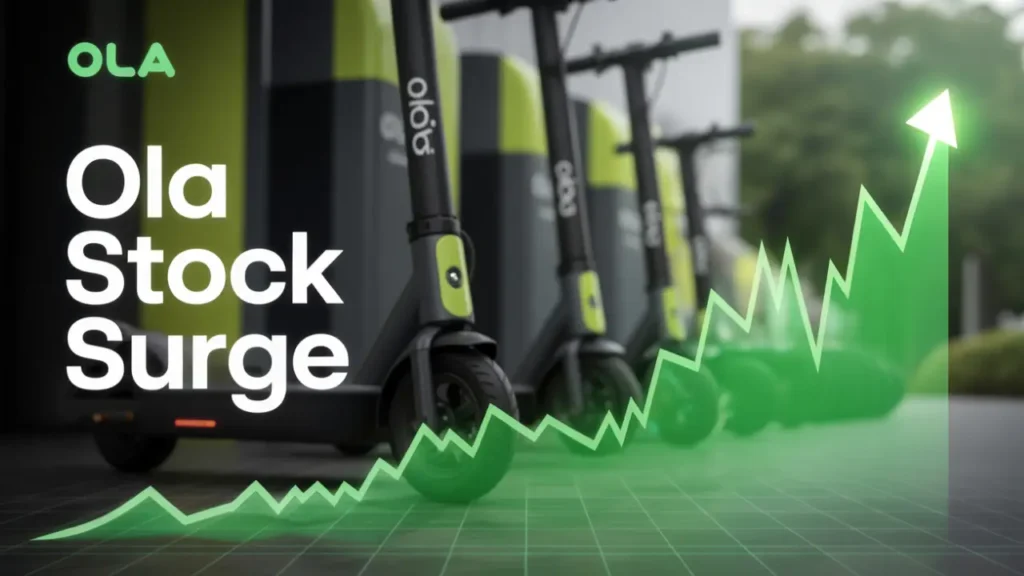Shares of Ola Electric Mobility have surprised investors this week with a sharp comeback, gaining more than 24% in just two trading sessions. On Tuesday, the stock jumped 8.5%, followed by another 14.5% surge on Wednesday. This comes as a relief for shareholders, as the stock had been under heavy pressure for most of the year, falling over 41% year-to-date and losing 63% in the last 12 months.
The sudden rally has sparked interest in the market, but analysts caution that the gains may be short-lived, especially with uncertainty over upcoming Goods and Services Tax (GST) reforms. Investors are now watching closely to see how government policy changes may impact the electric vehicle (EV) industry.

GST Reform: A Double-Edged Sword
The Indian government is currently working on plans to revise GST rates across several goods and services. For the automobile sector, this could be a game-changer. Currently, internal combustion engine (ICE) vehicles such as petrol and diesel cars are taxed at 28% plus cess, while electric vehicles enjoy a much lower 5% GST rate. This difference has been one of the key reasons EVs have been able to attract buyers despite higher upfront costs.
However, if GST on ICE vehicles is reduced, the price gap between EVs and traditional vehicles will shrink. This could make ICE vehicles more attractive again and slow down India’s EV adoption. Brokerages including HSBC Global Research and Nomura have already raised concerns, saying such tax cuts could hurt EV demand and challenge companies like Ola Electric.
For now, the market seems to be reacting in a mixed way—while investors are excited about the company’s latest product announcements, they are also cautious about the policy risks ahead.
Ola Electric Mobility Performance and New Product Launches
Despite the rally, Ola Electric’s financial results show a tough road ahead. In its Q1 FY26 results, the company reported a consolidated net loss of ₹428 crore, which is 23% higher than last year. Revenue from operations also fell sharply to ₹828 crore, almost half compared to the same period in FY25.
However, there is a silver lining. On a quarter-on-quarter basis, the company has shown some improvement, with losses narrowing compared to the previous quarter and revenues rising. This suggests the company may be slowly moving towards stability.
At its recent “Sankalp” event, Ola Electric unveiled several new innovations:
- The company confirmed the use of its indigenously developed 4680 battery cell in its S1 Pro Plus scooter and Roadster X Plus motorcycle, with deliveries starting during the upcoming Navaratri festival.
- Ola also introduced a new type of ferrite-based motor that eliminates the need for rare earth magnets, helping reduce dependence on imported materials and supply chain risks.
These developments are being seen as positive steps in strengthening Ola Electric’s position in the highly competitive EV market.
IPO Details and Shareholder Outlook
Ola Electric had earlier completed its much-awaited Initial Public Offering (IPO) on August 9, 2024. The IPO, open from August 2-6, was priced between ₹72-76 per share and received strong demand, with overall subscriptions reaching 4.26 times. Retail investors, in particular, showed high interest, subscribing to their portion 3.85 times.
For investors interested in buying Ola Electric shares today, they are available on both the BSE and NSE. Anyone can purchase them by opening a demat account with popular brokerage firms like Angel One, Zerodha, or Groww. However, experts warn that the stock has shown high volatility since its listing, and new investors should do their own research or seek advice before entering.
Currently, Ola Electric’s stock still trades below its long-term moving averages, which means that despite the rally, the broader trend remains weak. Yet, some market watchers believe this sharp bounce could indicate a possible bottoming-out phase, signaling that investor confidence may be returning.
The company’s future performance will now depend on two major factors: its ability to successfully roll out new products and its response to the changing GST framework. If Ola Electric can manage both, it could regain investor trust and strengthen its long-term growth story.
F.A.Q.
– Why did Ola Electric shares rise by 24% in two days?
Ola Electric shares surged due to renewed investor interest after the company announced new product launches, including its indigenously developed 4680 battery cell and ferrite-based motor. Despite weak financial results, the stock witnessed strong buying momentum, leading to a sharp rebound.
– How will GST reforms affect Ola Electric?
If the government reduces GST on petrol and diesel vehicles, the price gap between EVs and traditional vehicles will shrink. This could slow down EV adoption and negatively impact Ola Electric’s growth.
– What were Ola Electric’s Q1 FY26 results?
The company reported a consolidated net loss of ₹428 crore, which was 23% higher year-on-year. Revenue from operations fell to ₹828 crore, down by nearly 50% compared to last year. However, sequential results showed slight improvement.
– When did Ola Electric launch its IPO, and at what price?
Ola Electric completed its IPO on August 9, 2024, with a price band of ₹72-76 per share. The IPO was oversubscribed, with strong interest from both institutional and retail investors.
– How can investors buy Ola Electric shares now?
Ola Electric shares are listed on the BSE and NSE. Investors can buy them through a demat account with brokerage firms like Zerodha, Angel One, or Groww. Since the stock is highly volatile, it is advised to do proper research before investing.
Also read:-